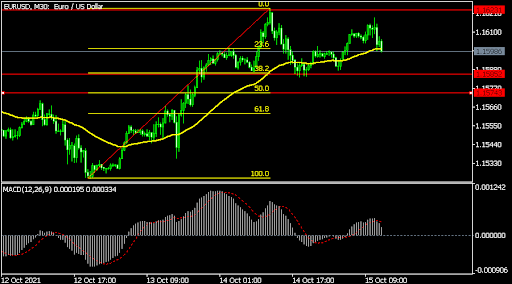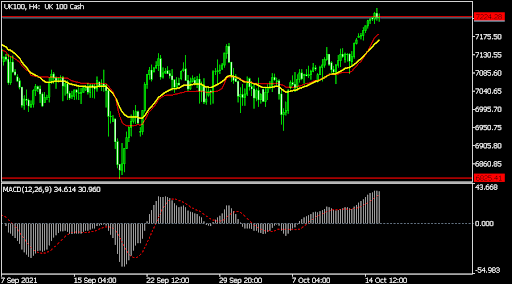The FTSE 100 jumped to the highest level since the pandemic started as investors ignored the rising risks in the market. In the UK, there is the ongoing risk of higher energy prices, supply shortages, and Brexit. In the past few weeks, the price of natural gas has soared, pushing more than 10 companies into bankruptcy.
At the same time, the shipping challenges have led to supply shortages while there is the growing risk of a trade war between the UK and the European Union. In a statement today, some members of EU countries urged the bloc’s leaders to set retaliatory measures should the UK suspend the Northern Ireland treaty. The best performers in the FTSE 100 index were IAG, Evraz, Ocado, Whitbread, and Glencore.
The Japanese yen declined sharply after Fumio Kishida made his first press conference as the country’s prime minister. The main headline was that he pledged to steer the country away from neoliberal fundamentalism championed by Shinzo Abe and Yoshihide Suga. He argued that these policies had failed to achieve substantial growth for the economy. He argued that while Abenomics delivered results in terms of GDP, employment, and earnings, it failed by not creating a virtuous cycle. He then said that the goal of most of his policies will be to lift incomes and trigger consumption.
Global stocks maintained a bullish trend as investors remained optimistic about corporate earnings. Results released so far have shown that many companies are doing relatively well. For example, banks like JP Morgan, Bank of America, and Morgan Stanley reported stronger-than-expected results, helped by investment banking and wealth management.
Other companies like UnitedHealth Group, Domino’s Pizza, and Blackrock have also published strong results. The earnings season will continue next week as companies like Albertsons, State Street, Philip Morris, and Netflix are expected to publish. In Europe, the DAX index, CAC 40, and Stoxx 50 rose by more than 0.30%. Similarly, futures tied to the S&P 500, Nasdaq 100, and Dow Jones rose by more than 0.20%.
USD/JPY
The USDJPY pair has seen a spectacular rally in the past few weeks. On the daily chart, the pair moved above the key resistance level at 111.80, which was the highest level this year. The pair remains above the short and longer-term moving averages. The DeMarker, MACD, and other oscillators have moved to the oversold levels. Therefore, while the overall outlook for the pair is bullish, a short pullback can’t be ruled out as some buyers start taking profits.
EUR/USD
The EURUSD pair retreated slightly today. It is trading at 1.1600, which is slightly below this week’s high of 1.1625. On the 30-minute chart, the pair has formed a double-top pattern and moved to the 25-period moving average. It is slightly above the chin of the double-top pattern at 1.1585. It has also declined slightly below the 23.6% Fibonacci retracement level. Therefore, the pair may keep falling as bears target the 50% retracement level at 1.1575.
UK100
The FTSE 100 rallied to the highest level since the pandemic started. It is trading at £7,225, which is substantially higher than September’s low at £6,825. On the four-hour chart, the index has moved above the important resistance level at £7,200. It is also above the 25-day and 50-day moving averages. Therefore, the index will likely keep rising in the coming weeks.
General Risk Warning for FX & CFD Trading. FX & CFDs are leveraged products. Trading in FX & CFDs related to foreign exchange, commodities, financial indices and other underlying variables, carry a high level of risk and can result in the loss of all of your investment. As such, FX & CFDs may not be appropriate for all investors. You should not invest money that you cannot afford to lose. Before deciding to trade, you should become aware of all the risks associated with FX & CFD trading, and seek advice from an independent and suitably licensed financial advisor. Under no circumstances shall we have any liability to any person or entity for (a) any loss or damage in whole or part caused by, resulting from, or relating to any transactions related to FX or CFDs or (b) any direct, indirect, special, consequential or incidental damages whatsoever.
Recommended Content
Editors’ Picks
AUD/USD could extend the recovery to 0.6500 and above

The enhanced risk appetite and the weakening of the Greenback enabled AUD/USD to build on the promising start to the week and trade closer to the key barrier at 0.6500 the figure ahead of key inflation figures in Australia.
EUR/USD now refocuses on the 200-day SMA

EUR/USD extended its positive momentum and rose above the 1.0700 yardstick, driven by the intense PMI-led retracement in the US Dollar as well as a prevailing risk-friendly environment in the FX universe.
Gold struggles around $2,325 despite broad US Dollar’s weakness

Gold reversed its direction and rose to the $2,320 area, erasing a large portion of its daily losses in the process. The benchmark 10-year US Treasury bond yield stays in the red below 4.6% following the weak US PMI data and supports XAU/USD.
Bitcoin price makes run for previous cycle highs as Morgan Stanley pushes BTC ETF exposure

Bitcoin (BTC) price strength continues to grow, three days after the fourth halving. Optimism continues to abound in the market as Bitcoiners envision a reclamation of previous cycle highs.
US versus the Eurozone: Inflation divergence causes monetary desynchronization

Historically there is a very close correlation between changes in US Treasury yields and German Bund yields. This is relevant at the current juncture, considering that the recent hawkish twist in the tone of the Federal Reserve might continue to push US long-term interest rates higher and put upward pressure on bond yields in the Eurozone.


